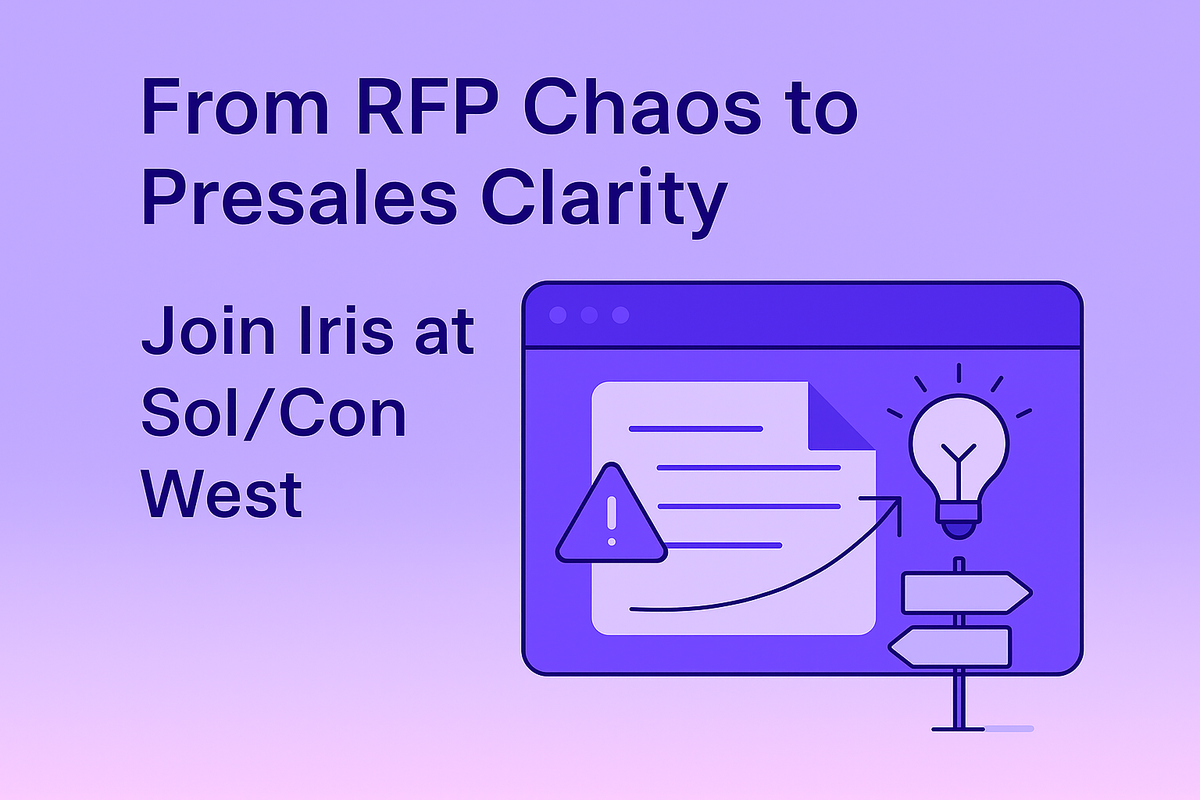RFQ Meaning: What It Is and When to Use It
May 12, 2025
By
Evie Secilmis

When you need a quick, clear answer from vendors on cost and timelines, you send a Request for Quote (RFQ). It’s not a conversation starter like an RFP; it’s a direct signal that you’re ready to make a decision. But to get the best response, you first need to grasp the complete rfq meaning and what it signals to your potential partners. Understanding the true meaning of rfq helps you treat every request as the near-closing opportunity it is. We’ll cover exactly what you need to know to get fast, accurate quotes every time.
In the world of procurement and vendor management, RFQ stands for Request for Quote. It’s one of the most direct and effective tools teams use to gather pricing when they already know exactly what they need.
In this post, we’ll break down what an RFQ actually means, when to use it, what to include, and how platforms like Iris help teams respond faster and with more accuracy—without the chaos.
What Does RFQ Mean?
An RFQ (Request for Quote) is a formal request sent to vendors asking for pricing and delivery details for specific goods or services. It’s used when requirements are clearly defined and you're looking for the best price, terms, or lead time—not a creative proposal or strategic plan.
In short: you know what you want—now you want to know what it’ll cost.
The RFQ in the Broader Procurement Process
An RFQ doesn’t exist in a vacuum. It’s part of a larger procurement ecosystem filled with other acronyms that can feel like alphabet soup. Understanding where the RFQ fits helps you anticipate the buyer’s journey and tailor your response accordingly. When you receive a request, the first step is to identify what kind of document it is, as that dictates the buyer's intent and how you should approach your reply. For sales teams, recognizing the difference between an RFI, RFQ, or RFT is crucial for allocating resources and crafting a winning strategy. It’s all about meeting the buyer where they are in their decision-making process.
Request for Information (RFI)
Think of a Request for Information (RFI) as the first step in the procurement dance. A company sends out an RFI when it’s exploring options and needs to gather general information about what potential vendors can offer. The requirements are usually loose because the buyer is still learning about the market and potential solutions. For your sales team, an RFI is less about closing a deal and more about educating the prospect and establishing your company as a credible expert. Responding effectively requires a solid knowledge base, and using an AI deal desk solution ensures your team can pull accurate, consistent information quickly, setting a strong foundation for future conversations.
Request for Tender (RFT)
A Request for Tender (RFT) is a more formal and structured invitation for suppliers to submit a bid to provide specific goods or services. You’ll often see RFTs used by government agencies and for large-scale projects where the procurement process is highly regulated. Unlike an RFQ, which can sometimes be informal, an RFT follows a strict set of rules for how bids must be submitted and evaluated. The focus is on a comprehensive offer that meets all the specified requirements, from technical capabilities to commercial terms. It’s a formal process where all bidders are judged on a level playing field, based on predefined criteria.
Alternative Meanings and Terminology for RFQ
Just when you think you’ve got the terminology down, you might run into the acronym "RFQ" being used in a completely different context. Depending on the industry or even the specific company, RFQ can stand for something other than a Request for Quote. This can be confusing, but knowing the alternative meanings helps you decipher exactly what the buyer is asking for. It’s a good reminder to always read the document carefully instead of just relying on the title. Understanding these nuances ensures you’re providing the right kind of information and not wasting time on a mismatched response.
Request for Qualifications
In certain sectors, particularly construction and professional services, RFQ can mean a Request for Qualifications. In this scenario, the buyer isn’t asking for a price just yet. Instead, they are pre-screening vendors to create a shortlist of qualified candidates for a project. The document asks for details about your company’s experience, team expertise, financial stability, and past performance. It’s essentially a vendor vetting process. Only the companies that meet the required qualifications will be invited to the next stage, which might be an RFP or a Request for Quote. It’s all about proving you have the chops to handle the job.
Invitation for Bid (IFB)
Sometimes, you’ll see the term Invitation for Bid (IFB) used interchangeably with Request for Quote. For all practical purposes, they mean the same thing. An Invitation for Bid is a solicitation where a company asks specific sellers to provide their best price for a clearly defined product or service. Just like an RFQ, the decision is almost always based on cost, since the scope of work is already set in stone. If you receive an IFB, you can treat it just as you would an RFQ: provide a clear, competitive, and detailed quote that directly addresses the buyer’s specifications.
When Should You Use an RFQ?
RFQs are ideal when:
- The product or service is well-defined and standardized
- You’re focused on comparing pricing, turnaround, or commercial terms
- There’s no need for vendor strategy or solutioning
- You want a clean, transactional way to evaluate vendors
Examples include:
- Ordering 500 licenses of a specific software
- Hiring a contractor for a set scope of work
- Procuring office equipment with fixed specifications
- Renewing standard support or service agreements with updated pricing
Why Choose an RFQ Over an RFP?
While RFPs are useful for evaluating strategy or customization, RFQs are better when the decision comes down to cost, delivery, and execution.
Teams choose RFQs when:
- The scope is crystal clear
- Pricing is the primary decision factor
- There’s no need for vendor interpretation
- The objective is procurement—not discovery
If a company sends an RFQ, it likely means:
- You’re already on their shortlist
- They trust you can deliver
- They want a fast, transactional response—not a pitch deck
RFQs cut through ambiguity and make it easy to compare vendors apples-to-apples.
Key Benefits of Using an RFQ
Using an RFQ isn’t just about getting a price; it’s a strategic move that brings clarity, speed, and reliability to the procurement process. For teams on both sides of the transaction, understanding these benefits is key to a smooth and successful engagement.
Essential for Budget Planning
When you know exactly what you need, the next logical question is, "How much will it cost?" This is where the RFQ shines. It allows you to gather and compare prices from different vendors to find the best value for your project. This process is fundamental for effective project budget management, as it gives you a clear picture of potential expenses right from the start. By understanding the cost landscape early on, you can allocate funds accurately, avoid unexpected financial surprises, and make informed decisions that keep your project on track and within its financial limits.
Saves Time and Reduces Paperwork
Beyond the budget, RFQs are a massive time-saver. Because you’re sending them to a pre-vetted list of vendors you already trust, you skip the lengthy discovery phase. The process is straightforward: you ask for a price, and you get one. This significantly cuts down on the back-and-forth and administrative overhead. The RFQ itself isn't a binding contract; it’s a precursor to a purchase order, which means there's less initial paperwork to manage. This streamlined approach allows teams to move quickly from request to decision, making the entire procurement process more efficient and letting everyone focus on execution rather than getting bogged down in documentation.
Ideal for Securing Ongoing Supplies
RFQs are particularly powerful for businesses that rely on a consistent and predictable supply of goods. Think about companies that need a steady stream of specific components, raw materials, or even standard office equipment. For these organizations, RFQs are crucial for establishing a reliable supply chain. They allow you to secure pricing and terms for products that must meet consistent specifications and quality standards. This isn't just about a one-time purchase; it's about building a dependable vendor relationship that supports your operations long-term, ensuring you always have what you need, when you need it, at a predictable cost.
What to Include in an RFQ (Simple Template)
Here’s a clean structure to build your next RFQ:
RFQ Template
1. Introduction
Brief summary of what you're requesting and why.
2. Scope of Work / Deliverables
Include quantities, specifications, timelines, and any technical requirements.
3. Submission Requirements
What vendors need to provide—unit pricing, bundled rates, terms, etc.
4. Timeline
- RFQ issued date
- Vendor question deadline
- Submission deadline
- Decision/award date
5. Evaluation Criteria
Optional, but helpful if you’re considering things beyond price—like lead time or warranty.
6. Point of Contact
Include the name, title, and contact details for the RFQ lead.
Understanding the Full RFQ Process
Responding to an RFQ isn't just about filling in a price; it's about understanding the game you're playing. The way a company requests quotes reveals a lot about its priorities and how it makes decisions. When you can identify the bidding method and anticipate the evaluation steps, you can tailor your response to give yourself the best possible chance of winning. This is where preparation makes all the difference. Having your most accurate and compelling information organized in a central knowledge base means you can adapt quickly and reply with confidence, no matter what format the buyer chooses.
Common Bidding Methods
Not all RFQs are created equal. Companies use different methods to gather bids, and each one comes with its own set of rules and expectations. An open bid, for example, is a public call where any interested vendor can submit a quote. This approach maximizes competition and often puts heavy emphasis on price. On the other hand, a sealed bid process is more like a silent auction. Every vendor submits their quote confidentially by a strict deadline, ensuring a level playing field where your first offer has to be your best and final one, as all bids are opened simultaneously.
Beyond those common methods, you might encounter an Invitation for Bid (IFB). An IFB is typically used for larger projects and is sent to a pre-vetted list of vendors. If you receive one, it’s a great sign—you’re already on the buyer’s shortlist. Then there’s the reverse auction, which flips the traditional model on its head. In this dynamic, real-time event, sellers compete by bidding prices down. This method is most common for standardized products where price is the primary, and sometimes only, deciding factor, creating a high-pressure environment that demands quick thinking.
Steps After Receiving Quotes
Once you’ve hit "send" on your quote, the ball is in the buyer’s court, but the process is far from over. Understanding what happens next can demystify the waiting game and help you prepare for follow-up conversations. First, the procurement team evaluates all submissions against their predefined criteria, weighing factors like price, delivery timelines, and commercial terms. After this review, they select the vendor that offers the best overall value—which isn't always the lowest price. From there, they may enter a negotiation phase to finalize details before officially awarding the contract and notifying the other bidders of their decision.
Common RFQ Pitfalls (and How to Avoid Them)
Even simple processes can go sideways. Here are a few RFQ mistakes we see often—and how to steer clear:
- Vague requirements
- Incomplete specs lead to incomplete quotes. Be clear and detailed.
- Treating it like an RFP
- If you’re asking for vendor insight or strategy, that’s not an RFQ. Keep it focused on pricing and fulfillment.
- Sending to unqualified vendors
- Don’t waste time on vendors who can’t meet your technical or timeline needs.
- No clear deadlines
- Without submission and review dates, quotes may come in too late—or not at all.
- Inconsistent formatting
- If every RFQ looks different, vendors spend time figuring out your process instead of responding quickly.
With Iris, you can standardize RFQs, maintain version control, and ensure everyone’s working from the same playbook—without the copy-paste chaos.
Best Practices for a Smooth Process
Avoiding pitfalls is one thing, but actively setting your RFQ process up for success is another. A few simple best practices can make a world of difference, ensuring you get clear, comparable quotes from the right vendors without unnecessary back-and-forth. It’s all about creating a structured process that respects everyone’s time and leads to a better final decision. By being deliberate from the start, you can streamline everything from vendor selection to final contract negotiations, making the entire procurement cycle more efficient and predictable for your team.
Set Pre-Screening Rules
Before you even send out your RFQ, it’s smart to establish some basic requirements to filter your vendor list. This isn't about being exclusive; it's about being efficient. Think about your non-negotiables. For example, you might only consider companies with specific industry certifications or a proven track record on projects of a similar scale. Setting these pre-screening rules helps you quickly narrow down the number of bids you need to review, saving you from wading through quotes from vendors who were never a good fit in the first place. This ensures you’re only spending time evaluating serious, qualified contenders.
Check for Hidden Fees
When the quotes start rolling in, it’s tempting to jump straight to the lowest number. But the initial price isn't always the final price. Take a moment to review each quote carefully for hidden fees or tricky contract terms that could make a cheap offer more expensive down the line. Look for line items covering shipping, taxes, implementation, or ongoing support costs. If a quote seems vague, don't hesitate to ask for a more detailed breakdown. A transparent vendor will be happy to provide one. This diligence helps you make a true apples-to-apples comparison and avoid any surprise costs later on.
Protect Your Company with Clear Terms
Your RFQ isn't just about price; it's also about setting expectations for the partnership. Protect your company by clearly outlining your required terms and conditions. This includes things like warranties for defects, service level agreements (SLAs), or penalties for late delivery. Being upfront about these requirements ensures that all vendors are bidding on the same terms and that you have recourse if things don't go as planned. Think of it as building a safety net into your procurement process. It clarifies responsibilities from the start and helps prevent future disputes, making for a much smoother vendor relationship.
A Critical Legal Note: An RFQ is Not a Binding Contract
Here’s a crucial point that can sometimes cause confusion: an RFQ is an invitation, not an offer. Submitting a quote is the vendor's offer, but the process doesn't create a legally binding agreement on its own. The final contract is only formed after you select a vendor and issue a formal purchase order or sign a separate agreement. This distinction is important because it gives both parties flexibility. It means you aren’t obligated to accept the lowest bid, and vendors aren’t locked in until a formal purchase order is accepted. Understanding this keeps expectations clear and legally sound for everyone involved.
Where Iris Comes In
Whether you’re issuing RFQs or responding to them, speed and clarity matter—especially when timelines are tight or internal reviews slow things down.
Iris helps teams:
- Auto-generate RFQ responses using AI-powered templates and pre-approved language
- Surface historical pricing and terms from past quotes
- Track edits, approvals, and internal comments with full audit trails
- Collaborate in real time—no endless threads or missed updates
Whether you're in sales, procurement, legal, or finance, Iris keeps your RFQ process clean, compliant, and fast.
Pro Tip: Keep It Clear and Consistent
Vendors love a clean RFQ. The more direct and well-structured your request, the faster and more accurate the quotes you’ll receive. Avoid ambiguity, define your expectations, and provide context.
And for vendors: tools like Iris help you respond faster, route questions automatically, and reuse approved language—without reinventing the wheel.
Final Thoughts
The RFQ is a simple but powerful tool when used right. Whether you're issuing one or responding to it, the key is structure, clarity, and speed.
Platforms like Iris make the RFQ process scalable—helping teams move quickly, respond confidently, and never lose track of what was said, sent, or signed.
Ready to take the friction out of RFQs?
Book a demo to see how Iris helps teams streamline their quote requests—from drafting to delivery.
Frequently Asked Questions
What’s the simplest way to decide between sending an RFQ and an RFP? Think of it this way: use an RFQ when you know exactly what you need and are just shopping for the best price and terms. It’s for standardized products or services. Use an RFP when you know what problem you need to solve but are open to different solutions and strategies from vendors. The RFP is about the "how," while the RFQ is about the "how much."
Does the lowest price automatically win an RFQ? Not always. While price is the primary factor in an RFQ, it's rarely the only one. Buyers also consider delivery timelines, warranty terms, and the vendor's reputation for reliability. A slightly higher bid from a vendor with a proven track record and faster delivery might offer better overall value than the absolute cheapest option, especially for time-sensitive projects.
What should I do if an RFQ I receive is too vague to provide an accurate quote? You should always ask for clarification. Submitting a quote based on assumptions is risky for both you and the buyer. Most RFQs include a deadline for questions, so use that opportunity to ask for the specific details you need. A professional, direct question shows you're thorough and helps the buyer get a more accurate comparison, which they will appreciate.
Is it okay to send an RFQ to only one vendor? Yes, this is a common practice, often called "sole-sourcing." It's useful when you have an established relationship with a preferred vendor and simply need to get formal pricing for a new project or renewal. It’s also used when a particular vendor is the only one who can provide a specific, proprietary product or service.
How can my RFQ response stand out if everyone is just competing on price? You can differentiate your response through professionalism and clarity. A quote that is easy to read, free of errors, and directly addresses every single requirement in the buyer's format will always stand out. Responding quickly and being available to answer follow-up questions promptly also demonstrates that you are organized and reliable, which can be a powerful tie-breaker.
Key Takeaways
- Treat an RFQ as a Closing Signal: When a buyer sends an RFQ, they have already defined their needs and are focused on price and terms. Prioritize these requests as late-stage opportunities that require a fast, direct, and competitive quote.
- Clarity Eliminates Guesswork: To get accurate and comparable quotes, be crystal clear in your request. Define the scope, specifications, quantities, and deadlines so vendors can give you a precise price without any confusion.
- Standardize Your Response Process: Winning RFQs often comes down to speed and consistency. Use a central knowledge base to quickly pull approved pricing, terms, and product details, ensuring every quote is professional and error-free.
Related Articles
Share this post
Link copied!



















